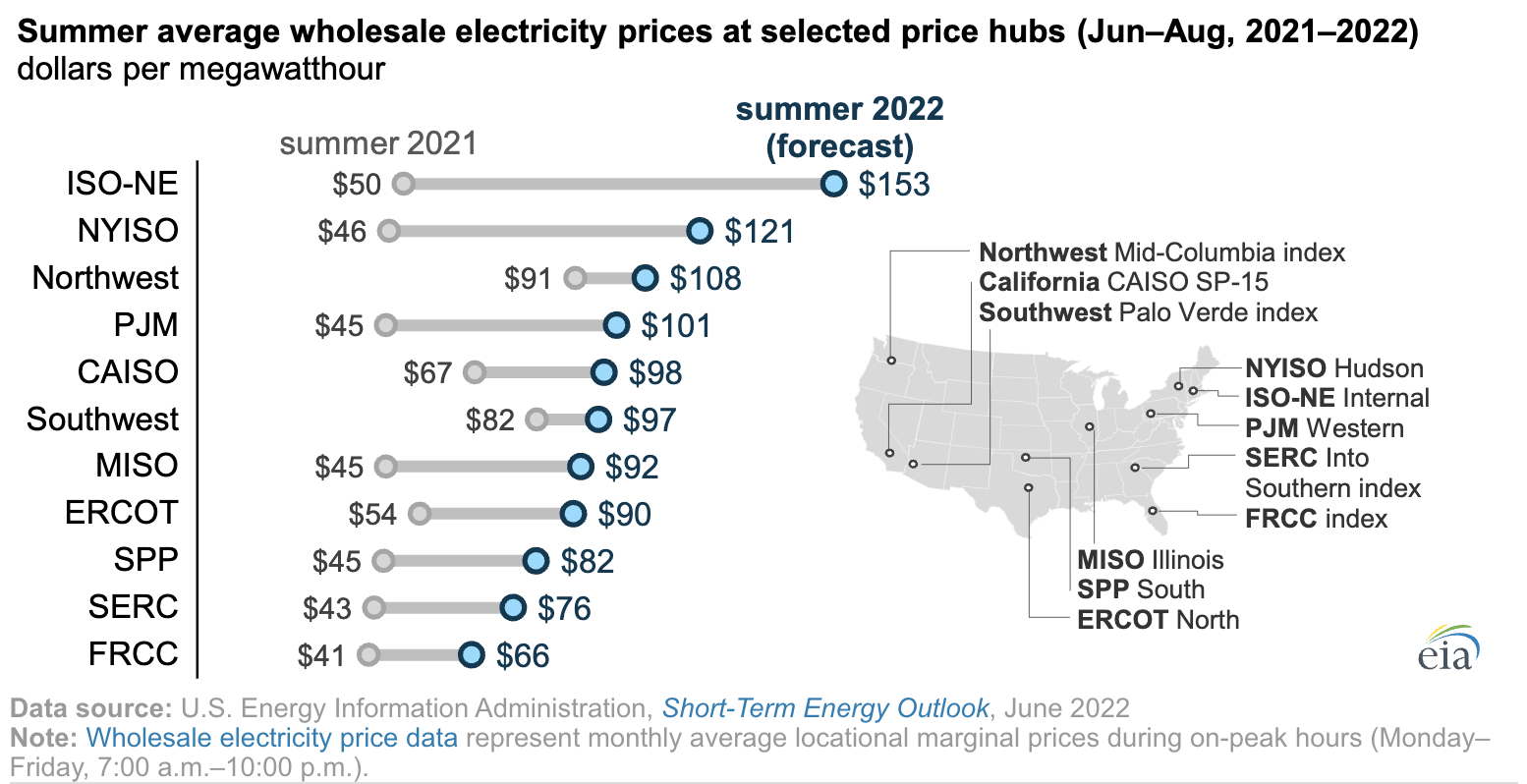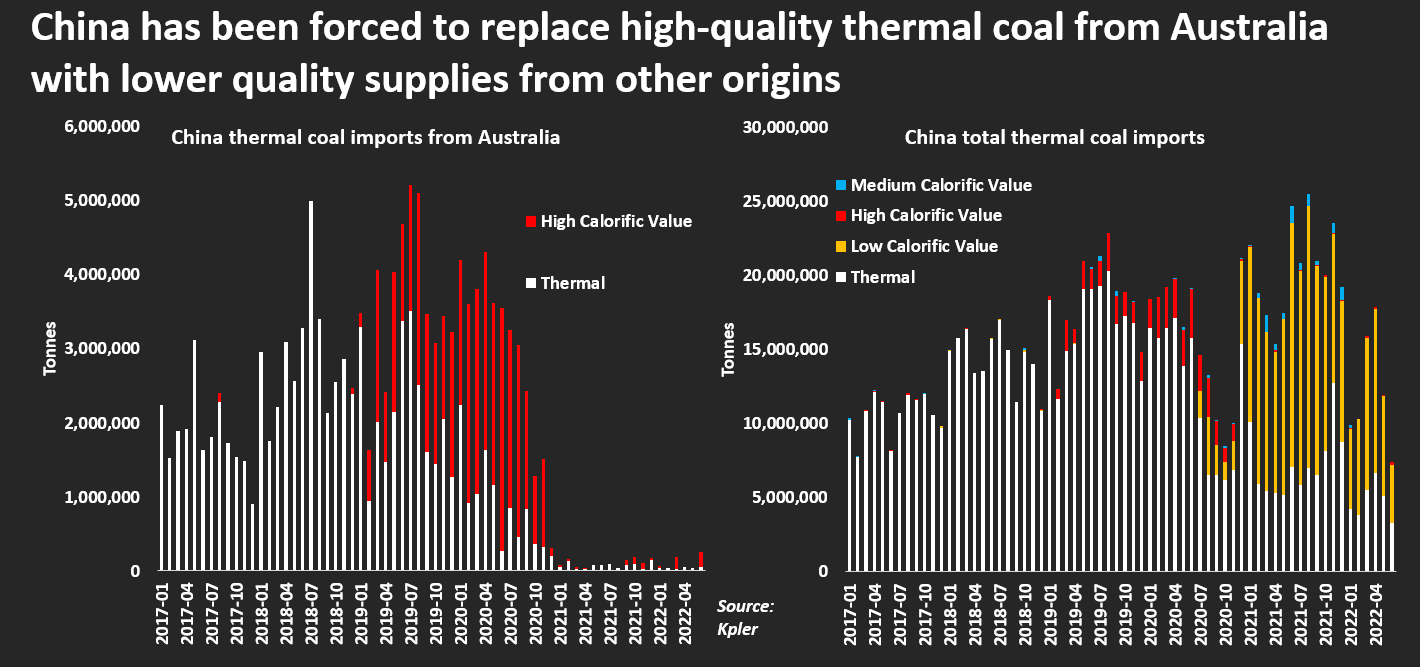Americans can expect higher electricity prices this summer, so says the Energy Information Administration (EIA) in its Short Term Energy Outlook. Some regions can expect wholesale electricity prices to double or triple, while other regions can expect price increases in the wholesale market to be closer to 18 percent. But, no region should expect lower wholesale electricity prices. The reason is that Biden administration policies have caused natural gas prices to triple, and it is the marginal fuel used for electricity generation that EIA expects to generate 40 percent of U.S. electricity this summer. When natural gas prices started increasing last year, U.S. electric utilities turned to existing coal generators, which generated 25 percent of U.S. electricity. However, some of those coal generators are being retired, and those that are not are facing constraints on coal shipments as well as having low levels of coal stocks on hand. Six percent of the coal capacity operating at the end of 2021 is scheduled to be retired this year—12.4 gigawatts of on-demand capacity.
According to EIA, New England can expect its wholesale electricity prices to triple and be the highest in the nation. New York’s wholesale electricity prices are expected to increase by a factor of 2.6 and the Pennsylvania, New Jersey and Maryland (PJM) interconnection’s wholesale electricity prices are expected to increase by a factor of 2.2. The PJM interconnection is currently holding a capacity market that will determine the fate of its coal plants depending on their bids. The Mid Continent area prices are also expected to more than double. Other areas are expected to see price increases, but none less than 18 percent.

EIA expects coal’s share of the generation market this summer to shrink to 23 percent. While the United States is retiring coal plants, other countries are generating their electricity mostly from coal, such as China and India. China and India have announced plans to increase their domestic coal production by a combined total of 700 million tons per year. That compares to total coal production in the United States of about 600 million tons. China gets 60 percent of its electricity generation from coal and India gets over 70 percent from coal. Despite China importing coal and LNG, it depends primarily on domestic fuel supplies for generating fuel needs, and controls local power and fuel prices and domestic coal output. China is very serious about reliable and affordable energy as the very cornerstone of a strong and growing economy.
European countries suffering under natural gas reductions from Russia are bringing idled coal plants back on line (as is the case for Germany), or announcing a possible emergency situation to allow the use of coal as in the Netherlands. Russia, who exports oil, natural gas and coal, gets 60 percent of its electricity from these fossil fuels.
China Increases Domestic Coal Production
Last year, China suffered under a power crunch, so the government increased production at domestic coal mines. In April, China announced it will increase coal output by 300 million tons this year. That record output has coal inventories at its utilities increasing by 50 million metric tons from the year before to 159 million metric tons in May. To meet the higher quotas, miners produced medium and low heating-value coal for the utility market, which requires that power plants burn more of that type of coal to generate the same amount of electricity as from higher heating-value coal. Some utilities in southern China increased coal use by almost 15 percent in late May from a year ago, but electricity output was almost the same. China also imports coal but it placed an unofficial ban on imports from high-grade coal producer Australia in late 2020 due to its stance on China being the origin of the coronavirus, and increased purchases from low-grade coal suppliers in Indonesia and Mongolia. Imports typically account for about 7 percent of China’s total coal consumption.

Greenhouse Gas Emissions Will Likely Increase World Wide
The International Energy Agency reported that global energy-related carbon dioxide emissions increased by 6 percent (36.3 billion metric tons) in 2021—their highest-ever level, as the world economy rebounded strongly from the Covid-19 pandemic and relied heavily on coal to power that growth. The increase in global carbon dioxide emissions of over 2 billion metric tons was the largest in history in absolute terms, more than offsetting the previous year’s pandemic-induced decline. Those emission gains occurred despite renewable power generation registering its largest ever growth. The world is demanding more electricity and political leaders are very aware of the link between power shortages, energy prices, and public discontent.
As China, India, and areas of Europe increase their coal consumption, it is likely that greenhouse gas emissions will increase as well. The United States seems to be one of the few countries that is following through with retiring coal plants in concert with John Kerry’s position at COP 26 of no coal plants by 2030. Other countries, however, are seeing the reality of energy shortages, high natural gas prices, and slowly increasing wind and solar power with all of their attendant costs upon the system. They see the need to continue to depend on coal to keep the lights on. It appears that China, India, and Russia are not trying to lower emissions but rather provide reliable power to their countries. The United States, in contrast, is putting a priority on reducing emissions rather than ensuring reliability and affordability.
In Russia, a remote-sensing satellite detected one of the largest releases of methane from a single industrial site, an underground coal mine in south-central Russia. Thirteen plumes of the gas were observed at the Raspadskya mine, the largest coal mine in Russia, in late January during a single pass of a satellite operated by a commercial emissions-monitoring firm. The total flow rate from all the plumes was estimated at about 87 metric tons (about 95 short tons) an hour. This is the largest source ever recorded. In comparison, the highest rate measured at Aliso Canyon, a natural gas storage facility in Southern California that had a major leak for nearly four months in 2015 and 2016, was about 60 metric tons an hour.
Conclusion
Americans will be getting hit with skyrocketing electricity prices this summer as the Biden administration places its priority on reducing greenhouse gas emissions rather than ensuring reliability. The United States is retiring 6 percent of its operable coal plants while other countries are continuing to use theirs or are bringing idled coal plants back online. Shortages of energy and high natural gas prices are making countries realize they need coal plants to ensure adequate supply. That means, greenhouse gas emissions will increase and any decreases from the United States will be a drop in the bucket. The next year should provide evidence of which path turns out to be correct.



